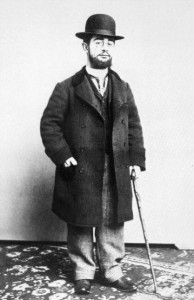Henri de Toulouse-Lautrec (1864-1901)
 Young Henri was barely 15 when an accident stopped his growth. He was 1m 52 tall for the rest of his life (under 5 feet). Unable to do much else for a distraction, he took up drawing, and soon discovered he had a talent for it. In the early 1880’s he moved to Paris to study art and became one of the most familiar figures of the bohemian world of Montmartre. His most famous paintings date from the very productive years 1889-94 that can be called his “Moulin Rouge years”. Consumed by alcohol, the “great little man” (Tristan Bernard) died in 1901 at the age of 37.
Young Henri was barely 15 when an accident stopped his growth. He was 1m 52 tall for the rest of his life (under 5 feet). Unable to do much else for a distraction, he took up drawing, and soon discovered he had a talent for it. In the early 1880’s he moved to Paris to study art and became one of the most familiar figures of the bohemian world of Montmartre. His most famous paintings date from the very productive years 1889-94 that can be called his “Moulin Rouge years”. Consumed by alcohol, the “great little man” (Tristan Bernard) died in 1901 at the age of 37.
With his sketchbook always at the ready, Toulouse-Lautrec became a sort of a witness to an underworld on the verge of change and no subject was unworthy of his pencil. “I paint the human figure, the people of the cabarets, the bohemians, the singers, the dancers, the actresses, the people of Montmartre”. Through his works, the respectable society (and the future generations) got a safe glimpse into a forbidden world.
Lautrec’s pencil goes for the essential, the expression rather than the actual features, without any poetry. Influenced by “japonisme” which was a prevalent style at the time, he keeps the concept of asymmetric composition and flat areas of color to produce those striking images we know.